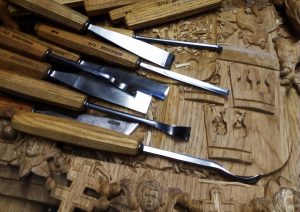On this page we gather translations of relevant posts and pages from the Swedish version of the website.
- Monograms
- Make your own owner’s mark
- Karl Sjögren; wood carver and journeyman of the year
- Do like Dietrich; get a journeyman’s diploma within the wood-working craft
- The last nail in the coffin – Wood worker Fredrik receives a scholarship
- Felix Wink and the urge for handicrafts!
- Spoon carver receives scholarship of 25 000 SEK!
Monograms
This year Hemslöjden is working with the overall theme ‘patterns and symbols’ which runs through the entire organization. Each month we highlight a different symbol and now it is time for the monogram.
- The word monogram means that a letter symbolizes an entire name and can consist of one or several letters, initials.
- A sample cloth (märkduk) works as a model and was used when embroidering.
- The monograms should be well made and visible, as for example on a wedding shirt (brudskjorta) where it is placed right below the split.
- In a monogram, the letters can be placed straight and simple right next to each other or form a pattern, for example by mirroring the letters towards one another.
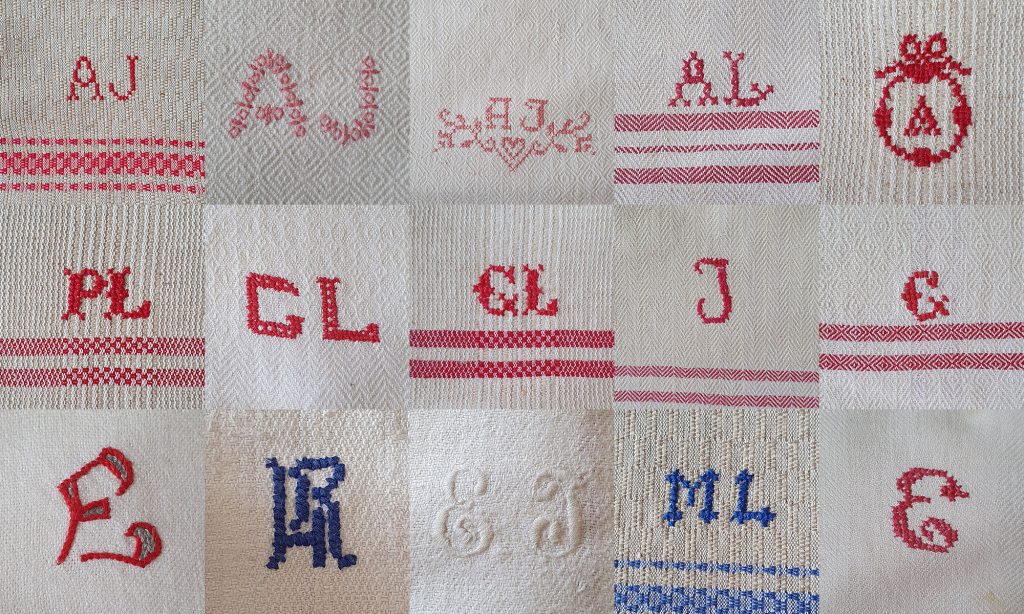
Many many monograms…
We have picked out a few monograms from Hemslöjdens collections on Digital museum. You can find them here.
Hemslöjdens collections consists of 45 000 unique handicraft items. A fourth of these have been digitalized and is shown on Digital museum, where you can also find 60 collections from different museums and local heritage associations.
Originally posted in March 2020. Link to the Swedish version of the post.
Make your own owner’s mark

Needlecase made from leather and wool with an embroidered owner’s mark.
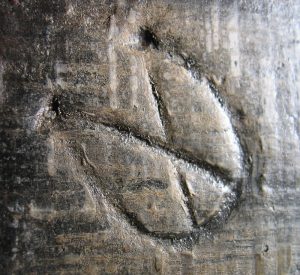
Detail of an owner’s mark on a box from the salvaged ship Vasa.
In historic times, the owner’s mark was a way to show ownership and was used as a signature instead of your name on legally binding contracts. While this is not the case today, owner marks can be both useful and enjoyable for us people of the 21st century. With the owner’s mark you can, in a nifty way, mark your belongings and sign your crafts. With that said, it is high time to make your own owner’s mark!
The owner’s mark also worked as a way to mark personal belongings. For analphabets they also worked as a signature, a legally binding document. The owner’s mark was also passed down from generation to generation, oftentimes they were connected to a specific farm.
How to make you own owner’s mark
The shape was simple, so that it easily could be carved in wood or stone. They often included symbols, e.g. runes to give luck, strength, richness and protection. Christian symbols also occurred.
With more and more people learning how to read and write, the use for the owner marks decreased. They are still used today for marking cattle, but not for much more which is a shame according to us. It is said that a picture says more than a thousand words and therefore we want to highlight the potential of the owner’s mark as a tag, logo, talisman and personal symbol! A visual complement for your own personal brand.
How do you want your owners mark to look?
Do you have any special interests or hobbies? Something that characterizes you? The stock nerd will maybe create an owner’s mark that resembles a dollar sign. The boat lover sneaks in an anchor and perhaps, the surfer wants to form their’s as a wave.
See your owner’s mark as a tattoo; it will follow you for the rest of your life. So put some time and effort into creating your timeless mark, so that it feels right even the day you turn 100 years old.
Good to have
- Pen, eraser, paper and ruler
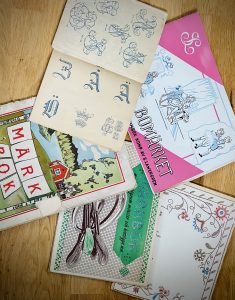
Old sample books – a gold mine for inspiration! Lucky ones can find these at flea markets, second-hand book stores or in their grandmothers bookshelf.
- A small mirror
Create a basis of knowledge
- Get inspiration from old sample books for embroidery.
- Read up on symbols, runes etc. Use the internet, go to the library or ask people with knowledge in the field!
- Take a look backwards into your family history – is there any old signet or monogram to work from? Do you live on a farm that maybe has an old owner’s mark connected to it?
- Digital museum – Search for owner marks (bomärken), signet (sigill) or monograms (monogram) and be inspired. You can borrow details and create something of your own.
- Collect signs, symbols, ornaments and letters.
Now it’s time so start building the mark!
How to
Decide what you want to include in your owner’s mark. Perhaps your own initials? A certain number? Scribble it down on a piece of paper to see how it looks.
When you have reached a decision on what to work further with, sketch it again on a new piece of paper.
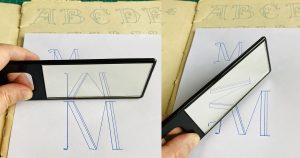
Let the mirror give ideas in the design process.
Take the mirror and see how it looks reversed. Rotate the paper and view your symbol from different angles. Does it look okay or do you suddenly feel different about the mark? Or does it look like an already existing symbol, e.g. a well-known logo?
Of course, you should refrain from making your owner’s mark too similar to recognized logotypes and brands. Also avoid using symbols with negative connotations, such as the swastika.
Design your mark after how and where you want to use it. Will it be carved in wood, embroidered, printed or painted? For the person who crafts in different materials, it is a good idea to try and shape your mark so that you will be able to sign various materials and to use different techniques. Embellishments are fun, but sometimes you have to be a little practical.
If you use your initials
Everyone does not use the same surname throughout their whole lives. So, think a little cynical and smart regarding this fact. Maybe the initial from your first name is enough? Another alternative is to rework the letters so that they more resemble a symbol rather than a monogram. By doing this it can feel fine using your owner’s mark throughout your entire life!
Use your owners mark!
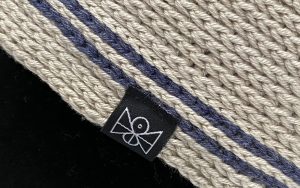
Completed owner’s mark!
When you have decided on a design – try it! Is the mark easy to write? How does it feel to embroider? Print? If you e.g. put your mark on a scarf it will be portrayed upside down from time to time. Does it feel like your mark even then? Simply take it for a test drive! Some small adjustments can be necessary but that will be noticeable after some time of use. Use it liberally for marking and signing your belongings. Because the owner’s mark is just like your jeans – they become better with wear.
Originally posted in April 2020. Link to the Swedish version of the post.
Karl Sjögren; wood carver and journeyman of the year
Karl Sjögren is one of the journeymen that on the 1st of November received their trade certificates at Stockholm City hall.
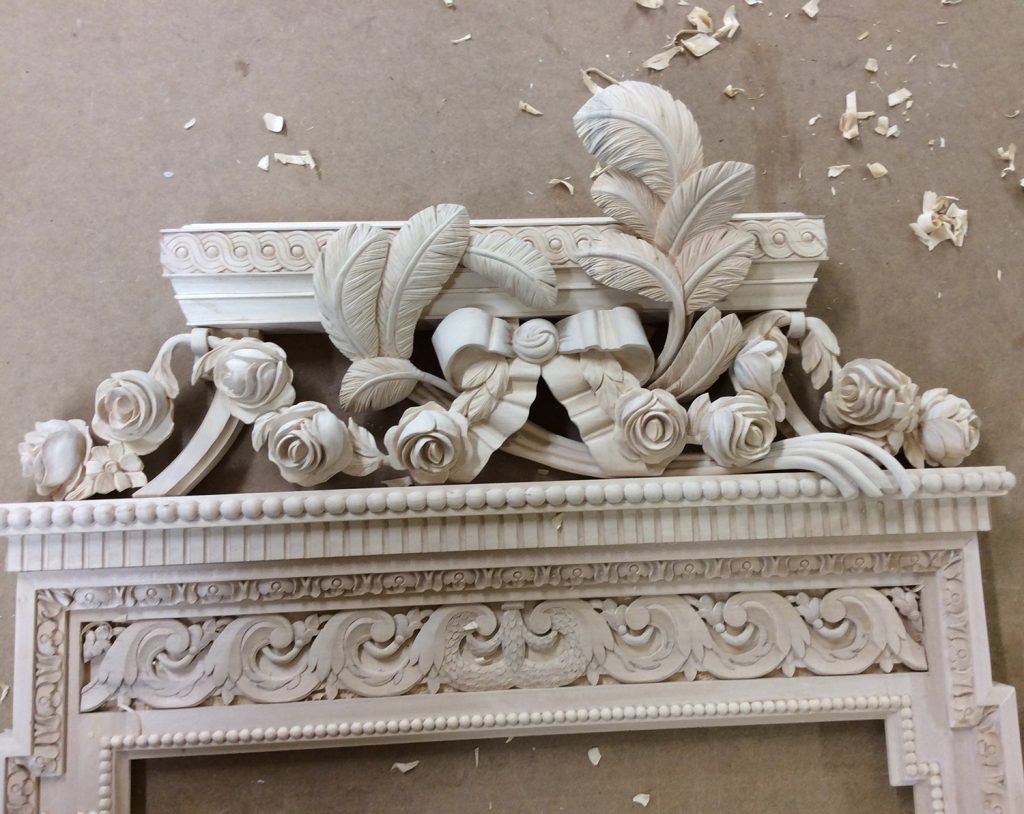
Mirror restored by Karl Sjögren.
He also received the honor – Journeyman of the year, which rewards him a scholarship of 20 000 sek. The money will be used for his journeyman years (Wanderjahre) in the south of England.

Woodcarver journeyman Karl Sjögren.
Stockholm Handicraft Association (Stockholms Hantverksförening) used this motivation in naming Journeyman of the year:
” For the title Journeyman of the year, Stockholm Handicraft Association have chosen a craftsman who is operating in a very unusual and narrow field. There are only a hand-full of practitioners in Sweden today. This journeyman has the ambition to conduct his Wanderjahre, in a contemporary way, to the south of England to document the cultural heritage environments that the royal wood carver Grinling Gibbons ornamented in the end of the 17th century and to visit two prominent and practicing wood carvers in London.
The Wanderjahre and the knowledge the Journeyman of the year – which is wood carver Karl Sjögren – will get during his travels will benefit the Swedish handicraft as well as our historical and newer environments, hopefully for many generations to come! “
For Karl – who has been dreaming of this for a long time – the award came as a very joyful piece of news. Finally, the Wanderjahre can happen, says Karl who has been dreaming of this for a long time. It is the richly decorated houses from the 17th century – Petworth House, Cassiobury House and Hampton Court Palace with ornaments made by Grinling Gibbons – that Karl especially look forward to study on his trip.
More about Karl
Karl is 27 years old and he grew up in Täby, just north of Stockholm. After studying philosophy at Uppsala University, he ended up at Sätergläntan institute for handicraft by coincidence, never before having held a carving knife in his hand.
After a few years of travel, he got a job at a chair’s factory in Tibro, where he manufactured period furniture. In Tibro there is also a Handicraft Centre, hosting one of the few educations for wood carvers in Europe. After three semesters there he graduated as a wood carver.
This fall, Karl launched his own business in the north of Roslagen. The assignments
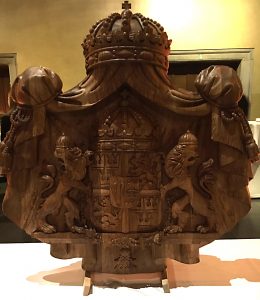
Karl Sjögrens journeyman’s exam in 2017: the Swedish weapon in oak!
he takes on, mostly consist of restorations for different cultural heritage environments, but also some new productions. On top of this, he is also active as a property man in Teater Oland. Right now, Karl is working on a chair for a play about Olof Rudbäck senior which premieres after Christmas. After New Year’s he will sculpt shoes for a clothing collection.
For his journeyman’s examination he created the Swedish weapon in Swedish oak, unpainted and coated with linseed-oil. The shield is carved from a piece of glued-together oak planks and none of the ornaments are glued on.
Originally posted in November 2017. Link to the Swedish version of the post.
Get a journeyman’s diploma in wood working
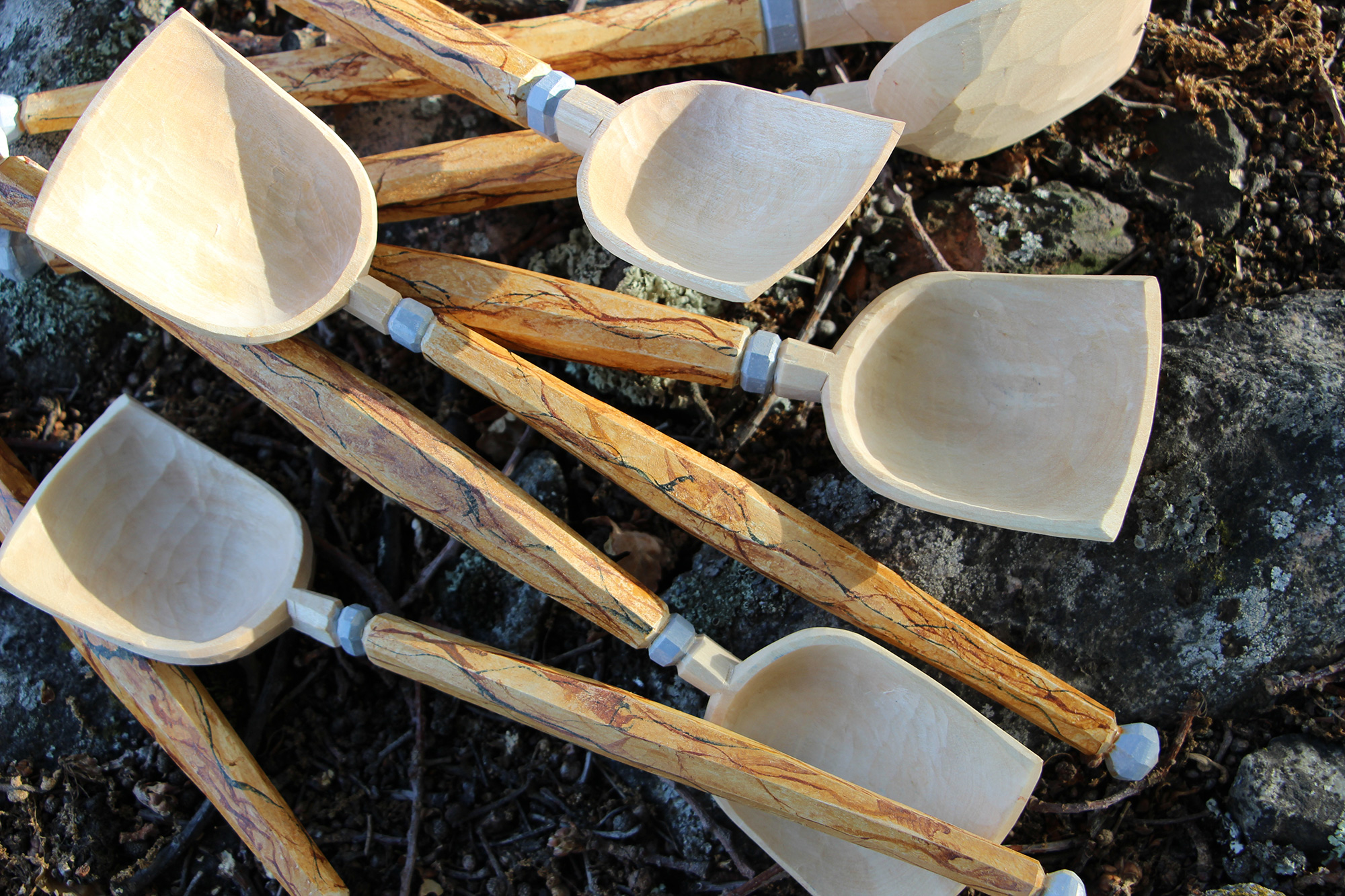
Spoons made by Dietrich Staemmler
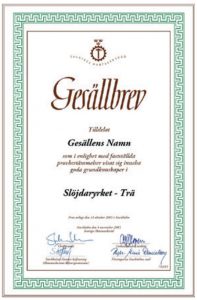 Do you like to create with wood? Do you know what an auger or an awl is? Can you manage a jigsaw and make a center dowel? If you know this, you surely know a lot more about other types of tools and techniques used in wood crafting.
Do you like to create with wood? Do you know what an auger or an awl is? Can you manage a jigsaw and make a center dowel? If you know this, you surely know a lot more about other types of tools and techniques used in wood crafting.
You who have completed a three-year education or gathered working experience (at least 2500 hours) within the field of wood crafting, can apply for going through with a journeyman’s exam. An approved journeyman’s exam will give you a journeyman’s diploma which is an international acknowledgment of your craftsmanship.
Dietrich Staemmler did just that, two years ago he became the first journeyman within woodworking in Sweden. He is a journeyman in furniture-making from Germany, who on his journeyman years (Wanderjahre), discovered the craft in a braided basket in a Finish sauna. After studying wood at Sätergläntan, he now has two journeyman’s diplomas – one in furniture-making and one in wood crafting!
Dietrich Staemmler
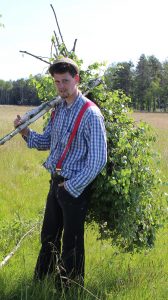
Dietrich Staemmler
He originally comes from Austria and have been working in many European countries, for example the Czech Republic, Switzerland, Great Britain and Sweden.
With local woods he finds in the forest or buys from small sawmills, Dietrich produces small series of ladles and spatulas. He also creates objects and furniture on demand, for example stools, chairs and shelves. After many years of experience, he has received a vast knowledge on different kinds of wood.
Oak, beech, birch, elm, ash tree, pine and fir are not just the names of different types of wood, it is different kinds of wood with different properties just like humans have various traits, Dietrich says.
Dietrich paints some of the objects and produces the paint himself. He believes that it is important to know what the paint contains. Therefore, he grates the pigments himself and mixes with traditional agents such as linseed-oil.
Dietrich is inspired by old craftsmanship and tries to translate this to the needs of our day and age.
The final product is a practical, ecologically produced and handmade object with an imaginative and personal touch.
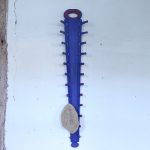
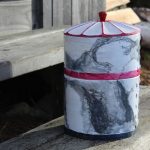
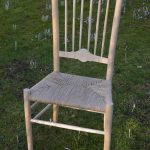
See more of Dietrich’s production here www.dietrichstaemmler.com.
Originally posted in December 2017. Link to the post in Swedish.
Wood worker Fredrik receives a scholarship
An interview with Fredrik Svensson who is receiving Sätergläntans Vänners (friends) scholarship of 10 000 sek to be able to apply for a journeyman’s diploma in the craft of wood working.

Fredrik Svensson received Sätergläntans Vänners scholarship in 2019.
The jury expressed:
”Fredrik Svensson is awarded Sätergläntans Vänners scholarship of 10 000 sek to be able to apply for a Journeyman’s diploma within the craft of wood working. Fredrik is also given the opportunity to buy material to be able to conduct his own handicraft business where he will create pieces with traditional techniques and with crafty shapes and surfaces.”
Who are you and what do you do?
My name is Fredrik Svensson and I come from Borlänge but now live in Gagnef. I preferably make furniture or other composed objects, but I also like braided elements in my work and neatly carved surfaces. In the daytime I am studying wood working at Sätergläntan.”
Why is it important for you to apply for a Journeyman’s diploma in the wood working trade?
It is a receipt that you are gaining knowledge within a handicraft trade, and it is also extra fun because it is kind of new.
You have received Sätergläntans Vänners scholarship of 10 000 sek! What does this scholarship mean to you?
It is a very nice encouragement and super fun that other people like what I do!
What opportunities do you see for the future of wood working?
Wood working as a vital tradition is perhaps outdated, but warehouse furniture made of plastic, saw dust and glue that does not last for more than a couple of years are even more old fashioned.
All the opportunities are there and Scandinavian wood working is spreading throughout the world in an amazing way. Here at Sätergläntan we notice a growing interest and that many people want to learn crafts and to really understand the material.
What are you up to next?
Now I will hit the final nail in a coffin. Well figuratively speaking, it is a wooden plug.
Originally posted in November 2019. Link to the post in Swedish.
Felix Wink and the urge for handicrafts!
An interview with Felix Wink who received Kerstin Andersson Åhlins scholarship to spread handicrafts with innovative methods.
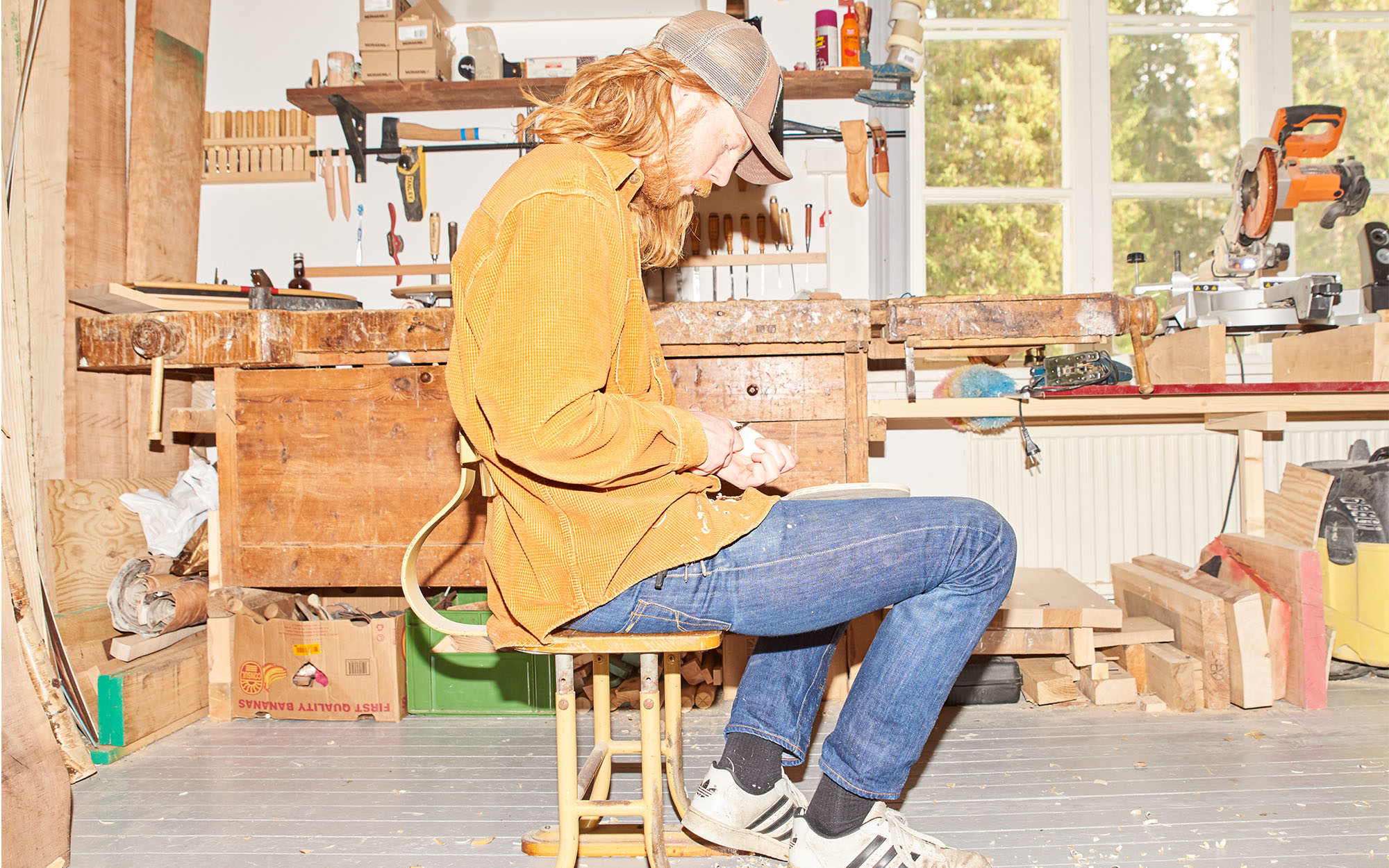
Felix Wink. Photo by: Per Björklund
The jury states:
”Felix Wink is 2019 awarded with Kerstin Andersson Åhlins scholarship of 10 000 sek for his frugal approach to handicrafts and crafting. With his communicative abilities and skill to connect different fields of knowledge, he enables more people to be able to craft.
Felix sees the needs and opportunities to craft using his hands. Thanks to his knowledge about materials and techniques, he manages to place handicrafts in a modern-day perspective. He explores and tries new methods and new collaborations to make the power and potential of the handcrafted more visible. In addition, he always mediates the importance of the material to receive a good result.
We hope that the scholarship can be of use in the creation of more innovative methods to keep spreading handicraft in a frugal fashion. “
Who are you and what do you do?
My name is Felix Wink and I live in the village of Nyåker in Västerbotten. I divide my days and nights between my job as a handicraft consultant oriented towards hard crafts and managing the company “Täljogram” together with my two friends David and Ragnar. My ambition in both fields is to spread the joy of creativity that exist within the handicraft field.
What do you find most exciting within the handicraft field at the moment?
The urge! The urge for handicrafts. I am experiencing a big interest at the moment, maybe because I am in the middle of it. Much is happening within the field. I think that much of it comes down to encounters. Interpersonal meetings, meetings between different points of view and knowledges. And not least the meeting between the tools, the practitioner and the material. It is lovely to work with handicraft right now!
Why is it important for the field of handicraft to develop?
Because handicraft should play a role in our age and be important for our future. There is a continuous development, it is the nature of it.
You have received Kerstin Andersson Åhlins scholarship of 10 000 sek! What does this scholarship mean to you?
It means a lot! That your work is noticed and encouraged like this makes me both happy and proud. I have the joy of working alongside other people, and without them many projects and ideas would not have happened and definitely had not been as good. I have many talented people around me to thank for this.
What opportunities do you see for the future of handicrafts?
Huge ones! There are opportunities for handicrafts to reach considerably wider and to be considerably more up to date in the public debate and in the work with sustainability. We who work with handicrafts are many and we constantly have to be on our toes, think outside the box and to challenge!
What are you doing next?
I am recently back at work after being on parental leave. So, at the moment I am throwing out some hooks here and there, we will see exactly what comes out of it. I also hope to be able to take the time for wood carving, because that makes me feel really good, preferably together with other people!
Originally posted in November 2019. Link to the post in Swedish.
Spoon carver receives scholarship of 25 000 SEK!
An interview with wood craftsman Björn Svantesson who received Bo Hammarskjölds scholarship of 25 000 sek to develop a deftness in carving spoons.
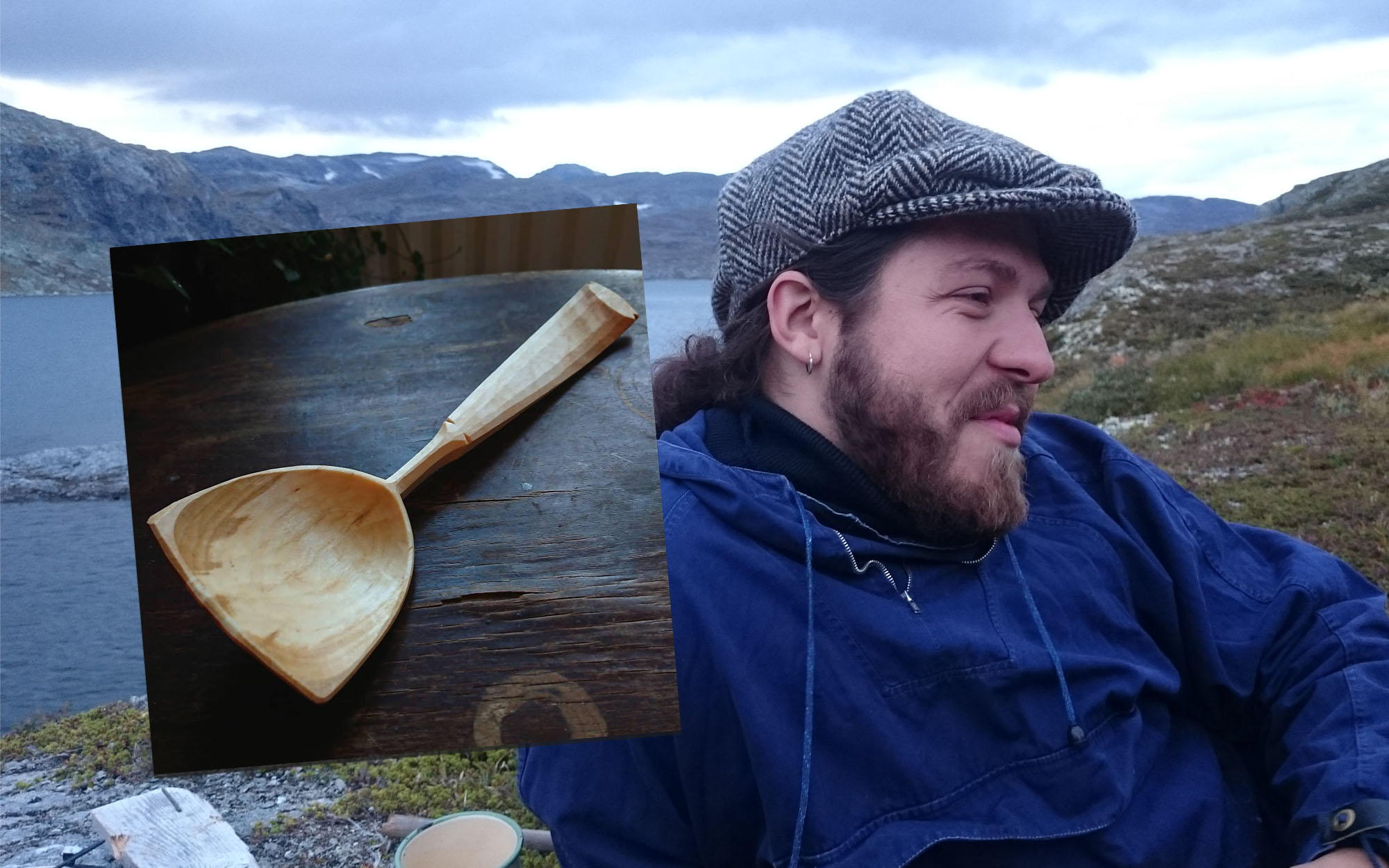
” Björn Svantesson receives 25 000 sek to be able to delve into the work progress and design studies, finding a deft expression in his craft. Björn wants to study how the carving of spoons changes during the process where the work is repeated time and again. This is, to be able to refine the work and attaining a deftness in the carving of wooden spoons.”
Who are you and what do you do?
My name is Björn Svantesson and I spend my time on different types of wooden crafts. Since a couple of years, I run my own business where I divide the time between architectural conservation and handicrafts, with spoon carving especially close to heart.
How did spoon carving arouse your interest?
My interest in carving spoons awoke about ten years ago when I studied my first year at Sätergläntan. It was fun and challenging from the first spoon and have only become more fun over time. There is something special about the combination of the strict form, that it is supposed to be a spoon, and the huge freedom in the spoon itself, a form that can be varied a thousand times over. It is a game of proportions that can be played over and over again.
You have received Bo Hammarskjölds scholarship of 25 000 sek! What does this scholarship mean to you?
The scholarship means a tremendous amount to me and I am very grateful for having been awarded it! The money gives me an opportunity to delve into spoon carving full-time for two months. Two months of focus on spoon carving will give me a continuity in the carving, which I otherwise would have a hard time being able to get. I also get an opportunity to explore the carving deeper and improve my processes.
It feels as if everyone is talking about wood carving at the moment! Have you picked up on this increased interest and if so, how?
Well yes, I have noticed the increased interest for wood carving, both on social media, such as Instagram, and in conversation with other people. A lot of people seem curious about carving and wooden crafts as a whole. I also think it is fun that it seems to be a growing exchange between craftsmen from different parts of the world, we have had several talented craftsmen here from England and the US as course leaders in the last couple of years.
What are you up to next?
I make a living working with architectural conservation, so I will spend my time until the end of the year with different restoration projects for private customers. Somewhere I want to squeeze in a week of preparations for the project of deft spoon carving. I need to gather wood, both for spoons and for a new chopping block.
Originally posted in November 2019. Link to the post in Swedish.
Page last updated on 2020-09-03
